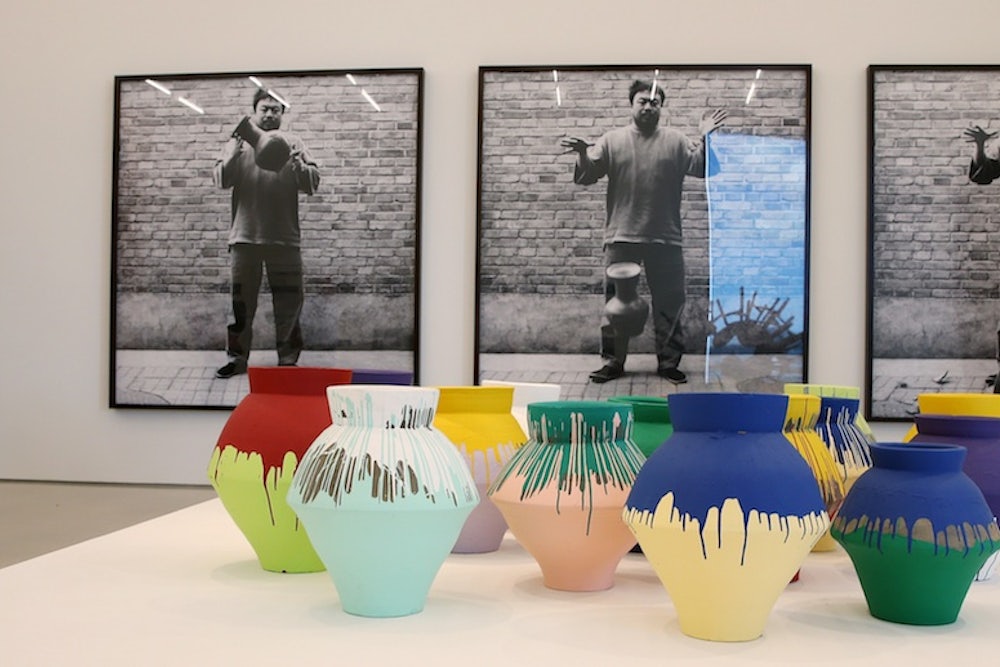Art world power brokers don’t know what to make of Maximo Caminero. At least they have been remarkably quiet. Caminero is the disgruntled Miami artist who a couple of weeks ago smashed an ancient pot that the Chinese dissident artist Ai Weiwei had covered in bright green paint. Of course this is vandalism. But the act ought to have a certain Dadaist appeal, at least at a time such as ours when so many curators, critics, and gallerists—let’s call them the Neo-Dadaists and Pseudo-Dadaists—argue that Dada’s dissident spirit is essential to the modern artistic experience. Caminero, who has apologized to the artist, faces criminal mischief charges. The complicating factor here is that Ai’s most famous work of art happens to be a set of three photographs in which he himself is shown smashing an ancient Chinese pot. So Camerino, whose own paintings are surrealist fantasies set in outer space, can quite naturally argue that he is just taking a lesson from the master’s protest art playbook. And indeed Caminero has explained that when he smashed Ai’s pot, it was an Ai-style protest. Caminero was protesting the underrepresentation of local Miami artists such as Maximo Caminero at the Pérez Art Museum in Miami, where Ai’s work is on display.
I find something weirdly fascinating about the entire affair. Is anybody surprised that such things can happen when Neo-Dadaism becomes canonical and the self-appointed rule breakers rule? Of course I am sorry to see an ancient pot smashed to smithereens. Then again, I have never been especially happy to see Ai covering pots such as this one with a layer of garish modern paint. And then there is the self-righteousness of Ai and his defenders. I don’t think it takes anything away from Ai’s courageous defense of civil rights in China to say that when it comes to purely artistic matters he’s pretty much a swaggering Neo-Dadaist poseur. Nihilistic grandstanding can have curious consequences. Ai seems to be arguing that there is no inherent problem with destroying or defacing antiquities, just so long as they are in your own possession. He’s a Neo-Dadaist who’s defending his property rights. “My only advice,” Ai has said, “is that he should make sure next time he knows—or have someone tell him—what he’s going to break. He thinks it’s from Home Depot?” Ai has a point. Then again, what does Ai expect? Is Ai saying that it’s okay to go into a museum and destroy inexpensive objects but not expensive objects? He apparently believes that his own decision to smash a pot is a viable subject for a work of art, the smashing photographically documented along with the artist’s own pokerfaced expression. So Caminero’s act is in the tradition of Ai’s original act—a Neo-Dadaist homage to a Neo-Dadaist act.
Caminero, who has said that he was angered by the difficulty of getting visibility for his own work in Miami when the work of a foreign artist was given such an opulent display, may have sincerely believed that he was making an Ai-esque gesture. Or perhaps Caminero is more of a con artist than he appears in press reports, and smashing Ai’s pot was a carefully planned attention-grabbing gambit. I have no way of knowing. What is beyond doubt is that he is relating his own artistic battles to Ai’s battles on behalf of his art and the people of China. “You were the vase in my hands,” Caminero has said, “and I was the silent voice of the artists of Miami”—much as Ai, through his protest art, gave voice to the silenced voices of China. One of Caminero’s supporters in Miami, who is involved in raising money for his defense, when asked how he would feel if Caminero destroyed one of his paintings, responded that he would not be bothered, just so long as the destructive act was an “unselfish, altruistic act” with a “humanitarian” ethos. Perhaps we have a new concept here. I know about the romance of ruins. But the humanism of destruction? Am I the only person who finds this bizarre? It is more than bizarre. Something has gone terribly wrong when destruction is associated with a humanitarian ethos. But then that idea is woven into Ai Weiwei’s work, because his smashing and repainting of ancient Chinese pots has somehow come to be associated with his status as a dissident artist in China.
Don’t ask me what it all means. In our topsy-turvy Neo-Dadaist world, meaninglessness can be the latest thing in meaning. But we do know perfectly well where it all began. First there was Duchamp, who defaced reproductions of Leonardo’s Mona Lisa with a moustache. Then there was Rauschenberg, who asked de Kooning to give him a drawing so he could erase it; a request to which de Kooning acceded, making sure Rauschenberg received one that would be especially difficult to turn back into a blank sheet. Those gestures of Duchamp’s and Rauschenberg’s were made at the Dadaist and Neo-Dadaist margins of the art world. Now the Dadaists and Neo-Dadaists and Pseudo-Dadaists have stormed the citadel. The halls of power are theirs. Ai Weiwei is by no means the only artist who has built a reputation on a belief in the death of the original and even the destruction of the original but now expects his work to be accorded the respect due to old-fashioned originals. Is it any wonder that a critical silence has descended around Maximo Caminero? The little guy’s dumb, scrappy Neo-Dadaist gesture is so totally last century.
